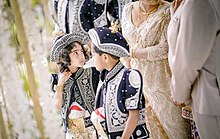
Back Singalese Afrikaans Sinhale ANG سنهاليون Arabic সিংহলী জনগোষ্ঠী Assamese Cingalés AST Sinhallar Azerbaijani سینهاللار AZB Сінгалы Byelorussian Синхали Bulgarian সিংহলি জাতি Bengali/Bangla
සිංහල ජනතාව | |
|---|---|
 Sinhalese children in folk costume | |
| Total population | |
| c. 17 million[1] | |
| Regions with significant populations | |
| 15.2 million (74.9%) (2012)[2] | |
| 108,069 (2022)[3] | |
| 58,166 (2021)[4] | |
| ~41,000 (2016)[5] | |
| 33,050 (2021)[6] | |
| ~17,000[7] | |
| 14,731 (2021)[8] | |
| 9,171 (2018)[9] | |
| ~5,300[10] | |
| ~4,700[11] | |
| Languages | |
| Sinhala | |
| Religion | |
| Majority: Minority:
| |
| Related ethnic groups | |
The Sinhalese people (Sinhala: සිංහල ජනතාව, romanized: Sinhala Janathāva), also known as the Sinhalese or Sinhala people are an Indo-Aryan ethno-linguistic group native to the island of Sri Lanka.[15][16] They are the largest ethnic group in Sri Lanka, constituting about 75% of the Sri Lankan population and number more than 15.2 million.[1][2]
The Sinhalese people speak Sinhala, an insular Indo-Aryan language. Sinhalese people are predominantly Theravada Buddhists,[17] although a significant minority of Sinhalese follow branches of Christianity and other religions. Since 1815, Sinhalese people were broadly divided into two subgroups: the up-country Sinhalese of the central mountainous regions, and the low-country Sinhalese of the coastal regions. Although both groups speak the same language, they are distinguished as they observe different cultural customs.[18][19]
According to the Mahavamsa, a Pali chronicle compiled by Buddhist monks of the Anuradhapura Maha Viharaya in Sri Lanka, the Sinhalese descend from settlers who immigrated to the island circa 543 BCE, from the legendary kingdom of Sinhapura led by Prince Vijaya, who mixed with later settlers from the Pandya kingdom.[20][21][22][23] Genetic analyses have found genetic affinity between the Sinhalese and South Indian populations, as well as links to other Indian populations such as the Maratha.[24]
- ^ a b "Sinhala". Ethnologue.
- ^ a b "A2 : Population by ethnic group according to districts, 2012". Department of Census & Statistics, Sri Lanka. Archived from the original on 28 April 2017. Retrieved 23 October 2012.
- ^ "Cittadini Stranieri Cingalesi in Italia". Tuttitalia, 2022. 1 January 2022. Retrieved 2 August 2023.
- ^ "Find Census Data – QuickStats – 2021 Census". Australian Bureau of Statistics. Retrieved 22 August 2023.
- ^ "Special Concerns for Sri Lankan American Voters – Foreign Policy and Terrorism". Sri Lankan American Action Coalition. Retrieved 2 September 2021.
- ^ "Knowledge of languages by age and gender: Canada, provinces and territories, census divisions and census subdivisions". Census Profile, 2021 Census. Statistics Canada Statistique Canada. 7 May 2021. Retrieved 3 January 2023.
- ^ "Sinhalese in Singapore".
- ^ "Population of the UK by country of birth and nationality". Office for National Statistics. Retrieved 22 August 2023.
- ^ "2018 Census ethnic group summaries | Stats NZ". www.stats.govt.nz. Statistics New Zealand. Sinhalese ethnic group. Retrieved 2 January 2021.
- ^ "Sinhalese in India".
- ^ "Sinhalese in Malaysia".
- ^ "Sri Lanka – Ethnic Groups".
- ^ "Sri Lanka – Ethnic Groups".
- ^ Kirk, R. L. (July 1976). "The legend of Prince Vijaya – a study of Sinhalese origins". American Journal of Physical Anthropology. 45 (1): 91–99. doi:10.1002/ajpa.1330450112. ISSN 0002-9483.
- ^ Sinnappah Arasaratnam; Gerald Hubert Peiris (7 April 2017). Sinhala Aryans. Britannica. Retrieved 1 June 2017.
- ^ Garrett Field (2017). Brothers of the Pure Sinhala Fraternity. University of California Press. pp. 34–55. JSTOR 10.1525/j.ctt1pq346x.8. Retrieved 10 May 2021.
- ^ Lewis, M. Paul, ed. (2009). Ethnologue: Languages of the World (16th ed.). Dallas, Texas: SIL International.
- ^ William Howard Wriggins (2015). Ceylon: Dilemmas of a New Nation. Princeton University Press. p. 22. ISBN 9781400876907.
- ^ Jiggins, Janice (1979). Caste and Family Politics Sinhalese 1947–1976. Cambridge University Press. p. 24. ISBN 9780521220699.
- ^ "The Coming of Vijaya". The Mahavamsa. 8 October 2011.
- ^ "The Mahavamsa The Consecrating of Vijaya – The island of Lanka – Kuvani". Mahavamsa.org. 13 March 2021. Retrieved 18 March 2022.
- ^ Gananath Obeyesekere, “Buddhism, ethnicity and Identity: A problem of Buddhist History,” in “Journal of Buddhist Ethics”, 10, (2003): 46 https://blogs.dickinson.edu/buddhistethics/files/2010/04/Obeyesekere.pdf
- ^ John M. Senaveratna (1997). The story of the Sinhalese from the most ancient times up to the end of "the Mahavansa" or Great dynasty. Asian Educational Services. pp. 7–22. ISBN 978-81-206-1271-6.
- ^ Cite error: The named reference
singhwas invoked but never defined (see the help page).